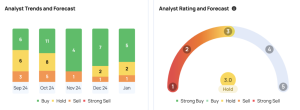
A stronger-than-expected December Purchasing Managers’ Index reading highlights resilience in the U.S. services sector, but rising price pressures and looming tariff concerns are casting shadows over an otherwise optimistic economic picture.
In a report released Tuesday, the Institute for Supply Management revealed that the Services PMI rose to 54.1% in December 2024, beating economist forecasts of 53.3% and marking a robust two-point gain from November’s 52.1%.
The data underscores the sector’s ongoing expansion, now at six consecutive months, with December’s reading representing the third-highest level of the year.
Steve Miller, chair of the ISM Services Business Survey Committee, said, “Nine industries reported growth in December, five fewer than the previous month’s total. The Services PMI has expanded in 22 of the last 24 months dating back to January 2023.”
What’s Driving US Services Sector Growth?
The uptick in the Services PMI was primarily fueled by business activity and supplier deliveries. ISM’s Business Activity Index climbed to 58.2 in December from 53.7 in November, signaling heightened end-of-year activity.
New orders also rose, with the corresponding index climbing to 54.2 from 53.7.
Yet, employment growth was flat, with the Employment Index holding steady at 51.4—indicating modest hiring across the sector.
Price Pressures Resume, Tariff Worries Loom Large
Despite the optimism, a sharp rise in the Prices Index has raised concerns about inflationary pressures within the services sector.
The index jumped to 64.4 in December from 58.2 in November, far exceeding consensus expectations of 57.5. Panelists cited input cost inflation, labor constraints, and tariff-related uncertainties as key drivers of price increases.
One of the more striking themes in the latest ISM survey was the emergence of tariff concerns as a key risk for businesses heading into 2025.
While specifics remain uncertain, companies are preparing for potential trade policy changes as the Trump administration is set to impose new tariffs within weeks.
Miller highlighted that “tariff concerns elicited the most panelist comments,” suggesting businesses are bracing for possible supply chain disruptions or cost escalations.
Labor Market Data Remains Strong
The Bureau of Labor Statistics released its Job Openings and Labor Turnover Survey data for November on Tuesday.
Job openings rose by 259,000 to 8.1 million, exceeding market expectations of 7.7 million. Vacancies were up for professional and business services by 273,000, finance and insurance by 105,000, and private educational services by 38,000.
The number of job quits declined to 3.07 million, the lowest since August 2020. The data suggests that while businesses are actively hiring, worker sentiment remains cautious amid rising economic uncertainties.
Market Reaction: Dollar Rallies, Bond Yields Surge
Financial markets reacted swiftly to the mixed economic data.
The U.S. Dollar Index (DXY), tracked by the Invesco DB USD Index Bullish Fund ETF UUP, climbed 0.3% by mid-morning trading Tuesday, partially recovering from Monday’s losses.
Bond markets saw sharp moves, with yields on longer-dated Treasurys rising by 6-7 basis points. The 30-year Treasury yield hit 4.90%, its highest level since early November 2023, sending the iShares 20+ Year Treasury Bond ETF TLT down by 1%.
Rising yields fueled concerns in equity markets. The CBOE Volatility Index (VIX) jumped 7%, reflecting heightened investor anxiety over rising inflation and bond yields.
All major indices slipped into negative territory, with the S&P 500 down 0.4% and the tech-heavy Nasdaq 100 falling 1%.
Within individual major stocks, Nvidia Corp. NVDA dropped over 3%, while Tesla Inc. TSLA slid nearly 4% following a downgrade to Neutral by Bank of America.
Read now:
Photo: Shutterstock
© 2025 Benzinga.com. Benzinga does not provide investment advice. All rights reserved.


